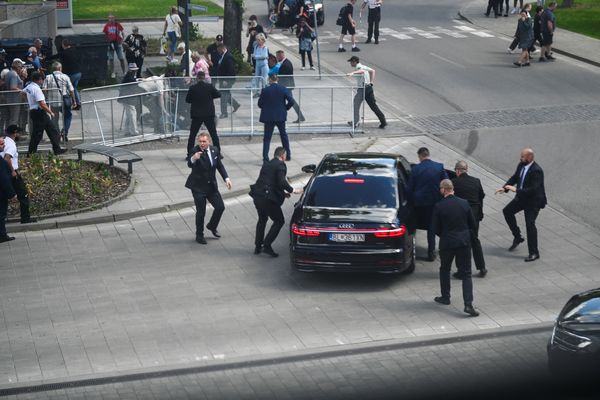
The Party: The Communist Party of Australia. Stuart Macintyre. Allen & Unwin.
Everyone who attended the memorial service for Frank Hardy at Collingwood (“Carringbush”) Town Hall in 1994 knew they were seeing the last of a certain type of event, the old, stately, working-class city auditorium filled with hundreds of leftists of every stripe, from suit and open-necked shirt Laboristas, rainbow social movement types, leather greaser anarchists, all crowded in for a last hurrah together of the grand project — and including not a few people who were there “just to make sure the bastard was actually dead”.
Hardy was a writer, an activist, an improbable European celebrity — hanging out with Jean-Paul Sartre and Nana Mouskouri at Les Deux Magots — and a liar, cheat and rogue of epic reputation. Nevertheless, as Stuart Macintyre records towards the very end of The Party, his concluding volume of the history of the Communist Party of Australia (CPA), Gough Whitlam spoke of Hardy’s introducing him to the Aboriginal land rights cause, and, gazing on the coffin draped in the Eureka and Aboriginal flags, choked up. It was then, not unremarkably, speaking to the memory of an ex-stalwart of the CPA.
And communists of course were there in profusion, among the inner-city gear and the suburban sleekness. Men and women in their seventies and eighties, in cardigans and grey flannel slacks, print dresses and twill coats, people who had marched for decades to be here, who had outlived the party they had made, even though most had left it decades before. By now, their dowdiness was exotic, the mark of a harder and more serious time.
Hardy, the manic artist, had denounced the party and the movement in 1969. A decade earlier he had written a book about a Russian visit — Journey into the Future — so Panglossian that it had claimed that under communism Russian women did not suffer pain during childbirth. Hardy was the gadfly, but it was these men and women who had put in the work, the endless hours selling the party paper, doing the meetings, the propaganda and agitation, the conferences and criticisms, the tedium and faction. What were they thinking, here at history’s afterparty, I wondered, with Goldman Sachs in Shanghai, and the tsars returned to Russia? What could this possibly feel like?
Macintyre’s book, his last, hitting the shops almost simultaneously with his death in 2021, gives an answer of sorts, but not in any grand oracular fashion or attempt at summing up, but rather in the steady and scrupulous history of the middle third of the party’s existence, running from the party’s being banned at the outbreak of World War II, to its decade or so of unlikely success after the USSR joined the allies, and its subsequent decline, from the 1950s onwards, picking up pace after the Khrushchev speech of 1956, and concluding with its moral revival, the only Western communist party to denounce the USSR’s invasion of Czechoslovakia, and a new influence in the new left social movements.
For anyone who’s been part of anything like it, it reads with the slow deliberate tension and pace of a thriller, its dutiful thoroughness as history communicating the movement’s dead seriousness. But by that very means, incident and colour are often eschewed, and a general reader may find it tough going, not only with regards to the party’s self-conception at the time, but also the author’s standpoint and his limits, as one of the onetime party faithful himself.
By the late 1930s, the Communist Party of Australia, from ramshackle, near mum-‘n’-dad beginnings, had become a force to be reckoned with. With a decade-long depression, the rise of fascism and Labor having split four ways, communists had the answer for the beaten down, from the Melbourne wharves to Port Hedland and Cape York. Voted to the head of unions for their militancy, communist candidates were getting 35-40% of the vote in state seats, though only one was elected (Fred Paterson in the Queensland cane fields, then perhaps the most radical place in the English-speaking world, south of Glasgow).
This success came from immense hard work, and Macintyre records both the minutiae of that — the papers sold, the budgeting, the membership drives, the instructions going to and fro — while noting also the nature of the leadership: collective and negotiated on the inside, monolithic from the perspective of the rank and file. Banning, due to the party’s anti-war activism until the USSR joined it, saw ingeniousness, amateurishness and heavy repression by the state. On the one hand, it was funny, as officials forgot to cancel mail orders, which led the plod directly to them; on the other, it was harsh, with people jailed for six months for lending someone a book by Lenin.
When Germany invaded the USSR, the CPA rushed so fast to join the war effort it squandered some political capital helping the government enforce wage caps and wartime long hours. Struggling out of that impasse, it set the pattern that would be its success and downfall: an expansion within the union movement to the point where it would run a third of the country’s unions, the largest presence in the Anglosphere, and an expansion of its social presence, as it took on the language of a radical patriotism — mateship and the notion of Australia as an inherently working class country — almost by accident, and with less than full support from the party’s older, more internationalist leaders, especially the wonderfully named Lance Sharkey.
When that social presence was not consciously maintained, as the Cold War came down, and the Menzies government attempted to ban it afresh, the party shrank fast, something its rueful veterans would look back on from the 1960s as a failure the French and Italian parties showed to be utterly unnecessary.
Thus paradoxically, the party succeeded best in the very opposite of what it had sought. It led a bruising coal miners strike in 1949, aimed at working-class uprising; the strike failed but persuaded both Labor and Liberal parties that wages and conditions had to start moving upwards again, which began to deradicalise. The party’s cultural activities — the New Theatre; the hugely successful folk musical Reedy River; communist popular authors selling half a million copies at a time — were aimed at creating popular radicalism, but really substituted a revived Australian vernacular, quashed by imported mass culture. If you sang “Click Go the Shears At School”, thank a communist. Oh come on, you liked it when you were six.
The movement’s greatest moral triumph was in recognising the political urgency of the full citizenship and humanity of Indigenous people — though it became tangled for a decade in a Marxist distinction between urban/mixed race and wilderness “full blood” First Peoples. Nevertheless, the party was organising station walk-offs and strikes in Western Australia in the 1930s, when “inducing an Aborigine to leave service” was a crime. One has to be wary of over-claim on the party’s behalf about action that First Peoples were organising themselves, but it was a relationship of solidarity not saviourism, to be distinguished from much that happens now.
Macintyre is assured in weaving these strands together, but he has a clear hierarchy of action in mind. This is a history of the party, not of the wider movement, and these extra activities illustrate the wider world within which the party sat. He has the restraint not to wreck his own work — as a writer like David Kemp does — with special pleading, digressions, defences or drive-by attacks on his subject’s adversaries. He dutifully records both the partial knowledge of the USSR’s crimes in the 1940s, and the failure of both organisation and individuals to have a confrontation with them, and records the fact of actual espionage by numerous party members well placed in the public service, which began towards the end of the war. He doesn’t duck the sleazy and gangsterish tone sections that the leadership would adopt, and the implicit attitude they communicated.
That is history served, but it misses the opportunity to demonstrate to the general reader just how central the communist movement was to the mobilisation of a more equal society, in the question of women’s rights; of Indigenous rights; of solidarity with the Indonesians and others fighting imperialism, urban heritage and equal rights for the city in the Green Bans movement; of free speech in endless battles of the communist-created Melbourne film festival; and of fighting book banning. Possibly he was a little tired of the oft-trotted-out cultural defence of a party that was too bamboozled for too long by fealty to the USSR: Stalinism is not greatly mitigated by film showings — and creating jazz festivals, others may claim, could constitute a greater crime.
Nor does he detour to some scenes that might have given a more explosive drama, such as the battles between communists, Trotskyists and then-US-funded anti-communists in the bruising, violent struggles in Sydney in 1949; or Doc Evatt, ALP opposition leader, acting as the CPA’s lawyer opposing legislation banning it in the High Court; or the cloak-and-dagger, gangster turn of the Petrov Affair, which not only split Labor but began the unravelling of the USSR’s UK spy network, ending in the exposure of Kim Philby.
To be fair, that would have demanded a book twice or more the length, and Macintyre, a Scot, not dour, but still a Scot, is not for being distracted here. He really is most fascinated by the ups and downs of newspaper sales, or debates over the distinction between rural and urban working class — and if you aren’t this is still a useful and pacy volume, but if you are it rips along like a James Ellroy. It concludes in the early ’70s with the split away of the pro-Soviet Socialist Party of Australia (SPA), the least SPA-like people who ever walked the earth.
The CPA had lost USSR funding in 1967; the SPA got it back, and used it to publish sexy calendars featuring pictures of twelve nuclear-powered Soviet icebreakers. SPA’s departure, Macintyre argues, allowed the CPA to become a small but creative party in its final 20 years, seeding social movements and doing much of the heavy lifting in reviving Labor intellectually, from the left, in the wake of the 1975 coup. Certainly, but like the final slim comedy of Russian four-part novels, there would be a fair bit of farce in it.
Macintyre’s refusal to pose the question of “What it was all for?” in simple terms, more or less prompts you to do so as you read. The party’s failure to induce working-class revolution coincided with its role — via Frank Hardy and others — in the Wave Hill walk-offs and the land rights movement. Communism in the world was one thing, a Western class movement, and then after 1945 it was mostly something else: a standing against a global imperialism that had every intent of drawing the world into its maw and creating an enslaving global apartheid of decades and decades and decades.
To its casual ruthlessness, communism posed a focus and purposive one, as the only force that could smash it. During the Wave Hill campaigns, Hardy interested a young, one-time-communist doctor in treating the blindness from rampant eye disease in desert Aboriginal people. Fred Hollows wasn’t a communist for long, but his slogan “every eye is an eye” is communist in spirit, to stand with the wretched of the earth against an enslaving radical evil, in the name of universal human flourishing, the small history of it here, in grey flannel and Fletcher Jones wool-knits, with this volume, arrived at its memorial.







